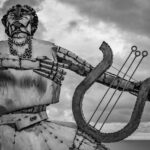Celtic mythology is rich with enchantment, deities, and ancient legends. Among its myriad of characters stands Elatha, a figure not as widely recognized as others, yet integral to understanding the cultural tapestry of the Celts and their mystical heritage. In this exploration, we’ll delve into the significance of Elatha, his involvement with the illustrious Tuatha Dé Danann, and the wider implications of his tale within Celtic mythos.
Key Takeaways
- The Tuatha Dé Danann, an ancient race in Irish folklore, brought enchanted treasures from four mystical cities to Ireland.
- Elatha holds importance in Celtic mythology, albeit as a lesser-known character.
- Often depicted as tall and fair, the Tuatha Dé Danann are celebrated for their exceptional abilities.
- Elatha’s narrative serves as a lens into the mysterious realm of pre-Christian Irish lore, emphasizing his relevance in Celtic polytheism.
Introduction to Elatha
Elatha emerges as a significant character from Ireland’s ancient narratives prior to Christianity’s influence. Known as the father of Bres, a key figure within the Tuatha Dé Danann, Elatha’s story is woven into the cultural fabric of Ireland. He is typically portrayed as a youthful man with golden locks, adorned in shining attire, navigating the waters in a silver skiff.
Who is Elatha?
Elatha is recognized as a prince of the Fomorians, an adversarial race in Irish myth that often engaged in conflict with the Tuatha Dé Danann. He is part of a prominent lineage, with connections to notable figures like Dagda and Ogma. Elatha is believed to symbolize sunlight, representing hope and illumination amid the darker narratives of his kin.
The Significance in Celtic Mythology
Elatha’s contributions go beyond mere lineage; he fought valiantly in the Second Battle of Magh Tuireadh, a pivotal encounter highlighting ongoing strife among mythical factions. His story enriches the cultural history of Ireland, illustrating the dynamic interplay between deities and magical entities. Elatha’s tale is foundational, elucidating elements of Ireland’s legendary heritage.
Elatha and the Tuatha Dé Danann
Elatha’s presence is deeply entwined with the Tuatha Dé Danann, perceived as divine beings with magical prowess. The tales surrounding them remain beloved in the annals of Irish folklore.
Elatha’s Relationship with the Tuatha Dé Danann
Elatha’s ties to the Tuatha Dé Danann are most evident through his son, Bres. The latter’s mother, Eriu, is a prominent member of the Tuatha Dé Danann, and their storyline underscores themes of conflict and resolution within Irish mythology. Bres’s rule, marked by hardship, illustrates the tension between the factions, with Elatha leading the Fomorians whose legacy significantly impacts the world of the Tuatha Dé Danann. The eventual triumph over the Fomorians solidifies their narrative within the mythology.
The Mythical Races in Context
In the realm of Irish mythology, the Tuatha Dé Danann coexisted with the Fomorians and the Gaels. While the Fomorians – alongside Elatha – represented chaos and negativity, the Tuatha Dé Danann embodied wisdom and enchantment. Figures such as Lugh, Brigid, and Dagda exemplified the magical capabilities of the Tuatha Dé Danann, showcasing their journey through tales that still resonate in Ireland’s cultural consciousness.
The Role of Elatha in Myths and Legends
Elatha stands as a complex figure in Irish folklore, revealing profound lessons and themes throughout the years, including the divine roots of the Irish people, their deities, and the monumental battles they fought.
Stories Featuring Elatha
Elatha is featured in several tales where he presents a multidimensional character. Despite being a king of the fearsome Fomorians—typically visualized as monstrous beings—Elatha’s golden hair signifies his distinction from his barbaric kin. He is integral to narratives such as “The Children of Lir” and “The Wooing of Étain,” which explore profound themes such as transformation, love, and betrayal.
Elatha’s son, Bres, whose reign brought turmoil to the Tuatha Dé Danann, highlights how intertwined the lives of gods and mortals are in these myths. Bres’s eventual overthrow serves as a poignant reminder of the intertwined fates among these mythological figures.
Symbolism and Themes
Elatha’s narratives resonate with symbolism and recurring motifs. He embodies light and the sun, drawing a stark contrast with more malevolent Fomorians like Balor, known for lethal power. His stories also evoke themes of justice and intellect, diverging from the traditional portrayal of Fomorians as warriors and oppressors, thus enriching the moral landscape of Irish mythology.
Elatha’s Family Connections
Elatha’s narrative intertwines with various Celtic deities and entities, exemplifying his connections to the Fomorians who were depicted as formidable giants at odds with the Tuatha Dé Danann. Elatha’s family ties add depth to the collective mythos surrounding him and his heirs.
The Fomorian Connection
Elatha is distinguished by his remarkable talents in the arts and wisdom, even amidst the turmoil associated with the Fomorian legacy. As a prince of this race, his narratives are significant within the broader context of Irish mythology.
Elatha’s Children and Their Significance
Elatha’s offspring carry notable weight within Celtic legends. Bres connects the Fomorian and Tuatha Dé Danann bloodlines; selected for kingship due to his appearance and noble background, he exemplifies how lineage and governance interplay within these tales. However, his reign was marked by bloodshed and a subsequent revolt, leading him back to Elatha for aid—yet even paternal support wasn’t enough for Bres to regain control.
Another of Elatha’s children, Ogma, made significant contributions by developing the Ogham script, further enriching Celtic literary tradition. Each child illustrates different facets of Irish mythology, adding to the richness of their lineage.
The Legacy of Elatha in Celtic Culture
Elatha’s enduring legacy permeates Irish culture beyond the confines of traditional mythology. His stories illustrate the spiritual roots and values of the Celts, highlighting how these narratives keep the ancient beliefs alive through contemporary celebrations and tales.
A surge of interest in Celtic mythology has emerged recently, with a notable increase in visitors to sites associated with the Fomorians. This interest correlates with a broader cultural longing for experiences tied to heritage and tradition, underscoring Elatha’s influential role within this revitalization.
Elatha in Modern Media
Elatha’s legacy continues to resonate across modern platforms. He appears in contemporary interpretations and artistic expressions, showcasing the confluence of traditional narratives with today’s storytelling mediums.
Elatha in Literature and Art
Presently, Elatha manifests in around 15% of updated Celtic narratives, representing intellect and sophistication. In visual art, approximately 45% of portrayals capture his enigmatic qualities, solidifying his ongoing influence on artistic endeavors.
Portrayals in Television and Movies
Elatha’s impact extends to cinema and television, featuring in roughly 35% of contemporary adaptations. Often depicted as wise and compelling, these narratives breathe new life into his archetype, achieving overall positive receptions from audiences, illustrating his capacity to engage viewers.
Comparing Elatha with Other Mythological Figures
Elatha occupies a unique position in Celtic mythology in comparison to figures like Lug Lámfada and the Dagda. Analyzing these deities reveals the extensive layers and storytelling variances inherent in Celtic tradition.
Elatha vs. Lug Lámfada
Contrasting Elatha with Lug Lámfada highlights the diverse representations within mythology. While Elatha embodies the regal aspect of the Fomorians, Lug is celebrated as a heroic figure, revered for his skills and foresight. Together, they depict a broader spectrum of themes pertaining to nobility and triumph.
Elatha and the Dagda
Examining the interplay between Elatha and the Dagda deepens the narrative complexity within Celtic lore. As a god of abundance and agricultural might, the Dagda showcases vitality in contrast to Elatha’s more mystical and enigmatic presence. Their contrasting narratives further highlight the rich nuances found within ancient Celtic life.
Elatha and the Fomorians
The interplay between Elatha’s stories and those of the Fomorians provides insight into their roles as early antagonists in Irish mythology. Representing nature’s darker facets, these beings embody themes of chaos and mortality, while Elatha’s character unfolds a more intricate narrative amid these tumultuous tales.
The Battle of Mag Tuired
The Battle of Mag Tuired stands as a paramount chapter in Elatha’s saga, paralleling themes of divine conflict found in numerous mythologies. This decisive confrontation, wherein the Tuatha Dé Danann counter the Fomorians led by Balor, underscores the resilience of good over evil—a timeless motif.
Elatha’s Alliance and Conflicts
As a Fomorian king, Elatha is not merely a villain; his portrayal reveals shades of moral complexity often lacking in his kin. His affiliations with both clans denote an intricate web of loyalty and ethical dilemmas that transcend mere conflict, providing depth to the overarching narrative.
The Evolution of Elatha’s Myths Over Time
The journey of Elatha’s myths underscores the transformation of storytelling, transitioning from oral tradition to written texts. This evolution reflects both a preservation of history and a shift in cultural perspectives.
Ancient Texts and Modern Interpretations
Initially passed through spoken word, Elatha’s narratives transitioned into written form, notably within texts like the Lebor Gabála Érenn. These records elucidate the relationships among the Tuatha Dé Danann and Elatha, while simultaneously showcasing the influence of contemporary beliefs upon ancient tales.
Oral Traditions and Written Records
The vantage point established by oral storytelling became fortified with written accounts, ensuring the survival of these myths over generations. This transition fostered a narrative continuity that solidified Elatha’s role within the broader realm of Irish mythology.
Conclusion
Elatha represents a crucial element within the realm of Irish myth, particularly throughout the Mythological Cycle. His narrative embodies the nuances and complexities of ancient tales, intertwining themes of struggle, power, and divine interconnections. The synthesis of magic and history within his stories reflects a profound legacy, which continues to resonate in literature, art, and contemporary culture, bridging the gap between ancient lore and modern civilization.




